Taylor D.A. Introduction to marine engineering
Подождите немного. Документ загружается.


330
Engineering materials
stress
reversals
are
counted
and the
machine
is run
until
the
specimen
breaks.
The
load
and the
number
of
reversals
are
noted
and the
procedure
repeated.
The
results
will
provide
a
limiting
fatigue
stress
or
fatigue
limit
for the
material.
Bend test
The
bend test determines
the
ductility
of a
material.
A
piece
of
material
is
bent through 180° around
a
former.
No
cracks should appear
on the
material
surface.
Non-destructive
testing
A
number
of
tests
are
available that
do not
damage
the
material under
test
and can
therefore
be
used
on the finished
item
if
required.
These
tests
are
mainly
examinations
of the
material
to
ensure that
it is
defect
free
and
they
do
not,
as
such, measure
properties.
Various
penetrant liquids
can be
used
to
detect surface cracks.
The
penetrant liquid
will
be
chosen
for its
ability
to
enter
the
smallest
of
cracks
and
remain
there.
A
means
of
detecting
the
penetrant
is
then
required which
may
be
an
ultra-violet light where
a fluorescent
penetrant
is
used.
Alternatively
a red dye
penetrant
may be
used
and
after
the
surface
is
wiped clean,
a
white developer
is
applied.
Radiography,
the use of
X-rays
or
-y-rays
to
darken
a
photographic
plate,
can be
used
to
detect internal
flaws
in
materials.
The
shadow
image
produced
will
show
any
variations
in
material density,
gas or
solid
inclusions,
etc.
Ultrasonic
testing
is the use of
high-frequency sound
waves
which
reflect
from
the far
side
of the
material.
The
reflected
waves
can be
displayed
on a
cathode
ray
oscilloscope.
Any
defects
will
also result
in
reflected
waves.
The
defect
can be
detected
in
size
and
location
within
the
material.
Iron
and
steel
production
Iron
and
steel
are the
most widely
used
materials
and a
knowledge
of
their manufacture
and
properties
is
very
useful.
Making
iron
is the first
stage
in the
production
of
steel.
Iron
ores
are
first
prepared
by
crushing, screening
and
roasting
with
limestone
and
coke.
The ore is
thus concentrated
and
prepared
for the
blast furnace.
A
mixture
of
ore, coke
and
limestone
is
used
to fill the
blast furnace.
Within
the
furnace
an
intense heat
is
generated
as a
result
of the
coke
burning.
Blasts
of air
entering
the
furnace towards
the
base assist
in
this

Engineering materials
331
burning
process.
The
iron
ore is
reduced
to
iron
and
falls
to the
base
of
the
furnace, becoming molten
as it
falls.
Various impurities, such
as
carbon, silicon, manganese
and
sulphur,
are
absorbed
by the
iron
as it
descends.
A
slag
of
various materials, combined
with
the
limestone,
forms
on top of the
iron.
The
slag
is
tapped
or
drawn
off
from
the
furnace
as
it
collects.
The
molten iron
may be
tapped
and run
into
moulds
to
make bars
of
pig
iron. Alternatively
it may be
transferred
while
molten
to a
steel manufacturing process.
Various
processes
are
used
in the
manufacture
of
steel,
such
as the
open hearth
process,
the
oxygen
or
basic oxygen
process
and the
electric
furnace
process.
The
terms
'acid'
or
'bask'
are
often
used
with
reference
to
steels.
These
terms refer
to the
production
process
and the
type
of
furnace lining, e.g.
an
alkaline
or
basic lining
is
tised
to
make
basic
steel.
The
choice
of
furnace lining
is
decided
by the raw
materials
used
in the
manufacture
of the
steel.
In all the
steel producing
processes
the hot
molten steel
is
exposed
to air or
oxygen which oxidises
the
impurities
to
refine
the pig
iron into high-quality steel.
Steels
produced
in the
above processes
will
all
contain
an
excess
of
oxygen
which
will
affect
the
material quality. Several finishing
treatments
are
used
in the final
steel casting. Rimmed steel
has
little
or
no
oxygen removing treatment,
and the
central
core
of the
solidified
ingot
is
therefore
a
mass
of
blow
holes.
Hot
rolling
of the
ingot usually
welds
up
most
of
these holes.
Killed
steel
is
produced
by
adding
aluminium
or
silicon before
the
molten steel
is
poured.
The
oxygen
forms
oxides
with
this material
and a
superior quality steel compared
with
rimmed steel
is
produced.
Vacuum
degassed
steels result from
reducing
the
atmospheric pressure
while
the
steel
is
molten.
This
reduces
the
oxygen content
and a final
deoxidation
can be
achieved
with
small
additions
of
silicon
or
aluminium.
Cast
iron
is
produced
by
rernelting
pig
iron under controlled
conditions
in a
miniature type
of
blast furnace known
as a
'cupola'.
Variations
of
alloying additions
may
also
be
made.
Two
main types
of
cast
iron
occur—'white'
and
'grey'.
The
colour relates
to the
appearance
of the
fractured surface. White cast iron
is
hard
and
brittle; grey
is
softer,
readily
machinable
and
less
brittle.
Heat
treatment consists
of
heating
a
metal alloy
to a
temperature
below
its
melting point
and
then cooling
it in a
particular manner.
The
result
is
some desired change
in the
material
properties.
Since most heat
treatment
is
applied
to
steel,
the
various terms
and
types
of
treatment
will
be
described
with
reference
to
steel.

.S32
Engineering
materials
Normalising.
The
steel
is
heated
to a
temperature
of
850-950°C,
depending
upon
its
carbon content,
and is
then allowed
to
coo!
in
air.
A
hard strong steel
with
a
refined grain structure
is
produced.
Annealing.
Again
the
steel
is
heated
to
around
850-950°C,
but it is
cooled
slowly,
either
in the
furnace
or an
insulated space.
A
softer, more
ductile,
steel than that
in the
normalised
condition,
is
produced.
Hardening.
The
steel
is
heated
to
850-950°C
and is
then rapidly
cooled
by
quenching
in oil or
water.
The
hardest possible
condition
for the
particular steel
is
thus produced
and the
tensile strength
is
increased.
Tempering.
This process
follows
the
quenching
of
steel
and
involves
reheating
to
some temperature
up to
about
680°C.
The
higher
the
tempering
temperature
the
lower
the
tensile properties
of the
material,
Once
tempered
the
metal
is
rapidly cooled
by
quenching.
Controlled
rolling.
This
is
sometimes described
as a
thermomechanical
treatment.
In
two-stage controlled rolling
an
initial
rough rolling
is
first.
carried
out at
950-1100°C.
The first
controlled rolling stage
is
carried
out
at
850-920°C.
The
second stage
is
completed
at
about
700—730°C.
The
process
is
designed
to
achieve
fine
grain
size,
improve
mechanical
properties
and
toughness,
and
enhance
weldability.
Material forming
In
the
production
of
engineering equipment various
different
processes
are
used
to
produce
the
assortment
of
component parts.
These
forming
or
shaping processes
can be
grouped
as
follows:
1.
Casting.
2.
Forging.
3.
Extruding.
4.
Sintering.
5.
Machining.
Casting
is the use of
molten metal poured into
a
mould
of the
desired
shape.
A
wooden pattern,
slightly
larger
in
dimensions than
the
desired
item,
to
allow
for
shrinkage,
may be
used
to
form
a
mould
in
sand. Entry
and
exit
holes,
the
gate
and
riser,
are
provided
for the
metal
in the
sand
mould.
Alternatively
a
permanent metal mould
or
'die'
may be
made
in
two
parts
and
used
to
make large quantities
of the
item. This
method
is
called
'die
casting'.
The
molten metal
may be
poured into
the
dies
or
forced
in
under pressure.
Forging
involves shaping
the
metal when
it is hot but not
molten.
In
the
manufacturing process
of
forging
a
pair
of die
blocks
have
the hot
metal
forced into them.
This
is
usually achieved
by
placing
the
metal
on
the
lower
half
die and
forcing
the top
half down
by a
hydraulic press.
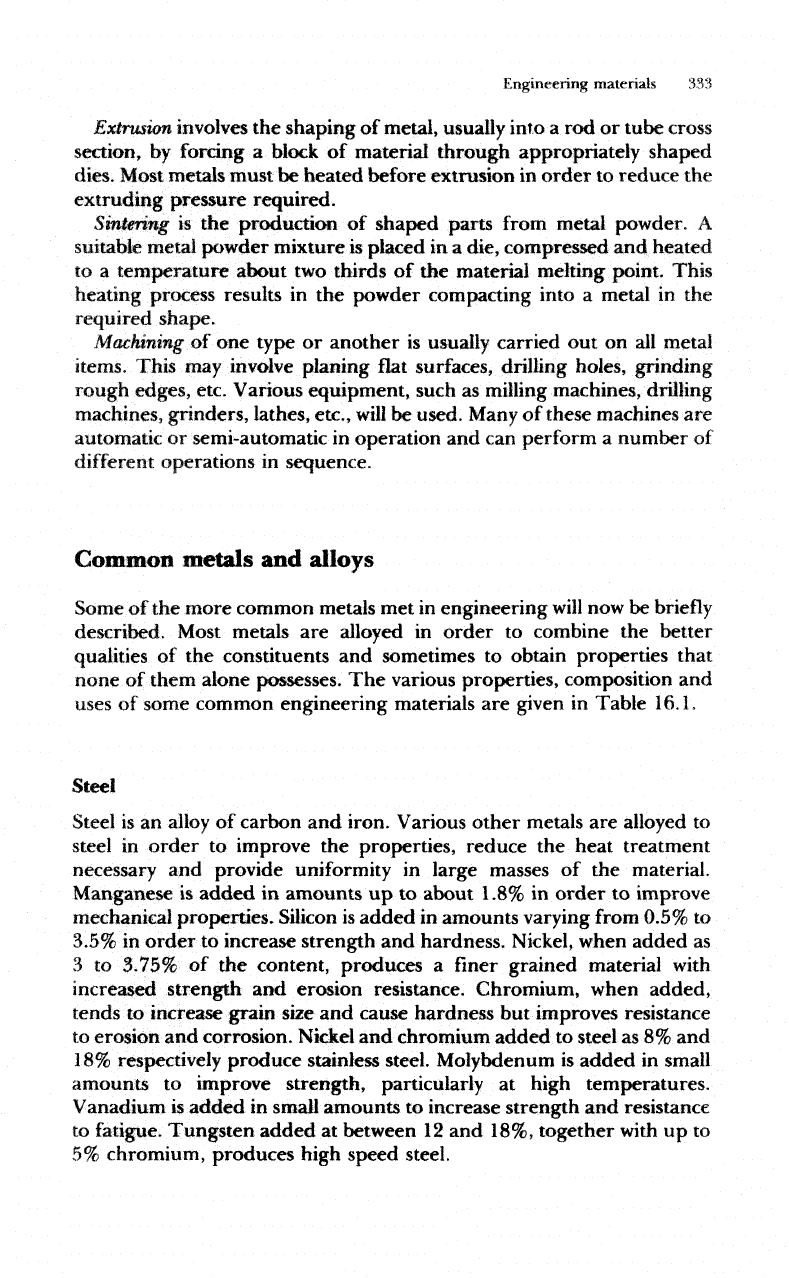
Engineering
materials
333
Extrusion
involves
the
shaping
of
metal,
usually
into
a rod or
tube cross
section,
by
forcing
a
block
of
material through appropriately shaped
dies. Most metals must
be
heated before extrusion
in
order
to
reduce
the
extruding
pressure
required.
Sintering
is the
production
of
shaped parts
from
metal powder.
A
suitable
metal powder mixture
is
placed
in a
die, compressed
and
heated
to a
temperature about
two
thirds
of the
material melting point. This
heating
process results
in the
powder compacting into
a
metal
in the
required
shape.
Machining
of one
type
or
another
is
usually
carried
out on all
metal
items.
This
may
involve
planing
flat
surfaces, drilling holes, grinding
rough edges, etc. Various
equipment,
such
as
milling
machines, drilling
machines,
grinders, lathes, etc.,
will
be
used.
Many
of
these machines
are
automatic
or
semi-automatic
in
operation
and can
perform
a
number
of
different
operations
in
sequence.
Common
metals
and
alloys
Some
of the
more common metals
met in
engineering
will
now be
briefly
described.
Most
metals
are
alloyed
in
order
to
combine
the
better
qualities
of the
constituents
and
sometimes
to
obtain properties that
none
of
them alone possesses.
The
various properties, composition
and
uses
of
some common engineering materials
are
given
in
Table
16.1,
Steel
Steel
is an
alloy
of
carbon
and
iron.
Various
other
metals
are
alloyed
to
steel
in
order
to
improve
the
properties, reduce
the
heat treatment
necessary
and
provide
uniformity
in
large masses
of the
material.
Manganese
is
added
in
amounts
up to
about
1.8%
in
order
to
improve
mechanical
properties.
Silicon
is
added
in
amounts
varying
from
0.5%
to
3.5%
in
order
to
increase strength
and
hardness.
Nickel,
when added
as
3 to
3.75%
of the
content, produces
a finer
grained material
with
increased strength
and
erosion resistance. Chromium,
when
added,
tends
to
increase grain size
and
cause hardness
but
improves resistance
to
erosion
and
corrosion. Nickel
and
chromium
added
to
steel
as 8% and
18%
respectively
produce
stainless steel. Molybdenum
is
added
in
small
amounts
to
improve strength, particularly
at
high temperatures.
Vanadium
is
added
in
small amounts
to
increase strength
and
resistance
to
fatigue.
Tungsten
added
at
between
12 and
18%, together
with
up to
5%
chromium, produces high speed steel.
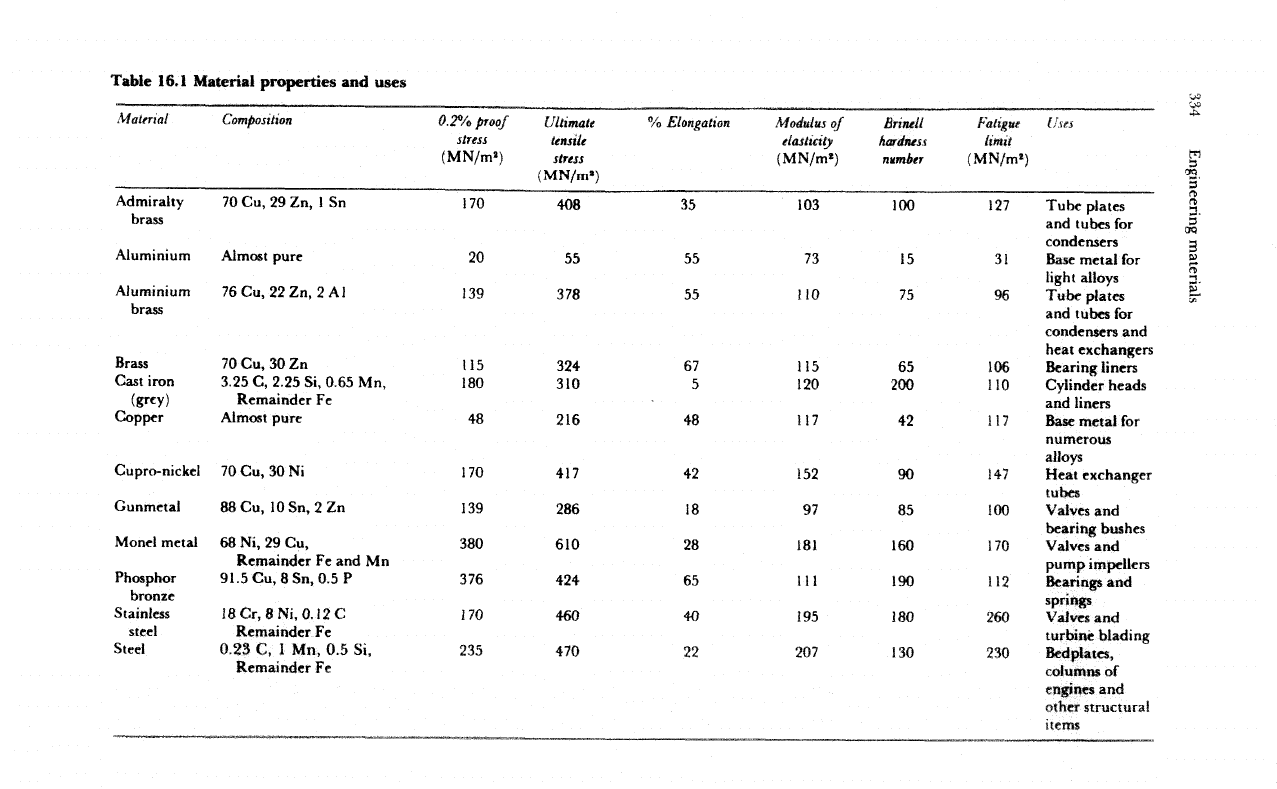
334
Engineering
materials
m
<f.
53
"0
G
a
$
«M
a.
TS
i
«M
1
W^
III
"*•
2s
H
i
•§
||l
a*
ft
S3
*2
ty
I
1
**
1
O
S3
•2*
M
5°*
5
t^
6
^
^
6
O
^j
•ft,
"•>
-5.
O
S
^7
1"^
Composition
"3
t
1
Tube plates
and
tubes
for
CM
8
CO
o
in
CO
*
O
i"**
t/3
—
*
c"
N
8
•3
O
o
>^
Admiralt
brass
condensers
Base
metal
for
light
alloys
Tube plates
and
tubes
for
CO
<J)
in
in
CO
O
in in
in
m
in
oo
in
t^
CO
o
ch
CM
CO
<
CM
IL>
c
"
to N
3 CM
"•
CM
g
3
i o
E
E
S
2
5
'S
a
"E
1 2
3 3
JD
<
<
condensers
and
heat exchangers
Bearing liners
Cylinder
heads
and
liners
Base
metal
for
IS
S
mo
CM
iO
O
r^"
r—
1
(SI
«MH«
r^
in
00
<-O
"!j"
CM
S
i£
CO CO CM
in
o oo
—
CO
*
„
c
S
O
«J
f
U-I
a
^
fc
30
|
g
r»-
co
^,
£
^
*•
£8
O
(3
numerous
alloys
Heat
exchanger
5
s
CM
in
CM
"*•
•*
o
Z
S?
0
o
"u
'5
i
a.
3
O
tubes
Valves
and
8
00
en
oo
<JS
CO
CM
CD
CO
c
N
CM
Crt
O
a"
O
Gunmeta
«
f2
g
3
13
*U
(y
C
U
a
-o"X.l
T
^
-'s
"i
«
-S"j*s*i'
B
.S
p
a.S
||
J
£
1
|
H
*
ll
II
12
11
III
I
O CM O O
r~
—
ys
eo
—
t
—
CM
(M
UD
C^
CO
CO
00
—
«
CT> O
—
i
—
«
~
CM
oo
in
o CM
CM
«5
•*
CM
O
•<*•
Q O
to
•<$«
^«
^«
O (O O
ITS
CO
r-»
r~-
co
CO
CO
-i
CM
C
^
.
jr
"O
C/3
g
ft. Q
^
W
X
CM
«°
«
b«
0
2
U,
.U,
3-
fe
,£
«
fc
s
fc
A
'-5
<w
.„-
-S
<*
-S
^Joo
g|«l
S
«
a"
eo
3 - *
N
.
6 Q t- S 0 6
S
W
W
r
*?
W
-_
<U
gojin
Orf.gjrf
S 5
2
o"
_
2
1
iss-
^
O* O
"S
^
o
.c
a
**
£
2
ft.
<J5
e/5
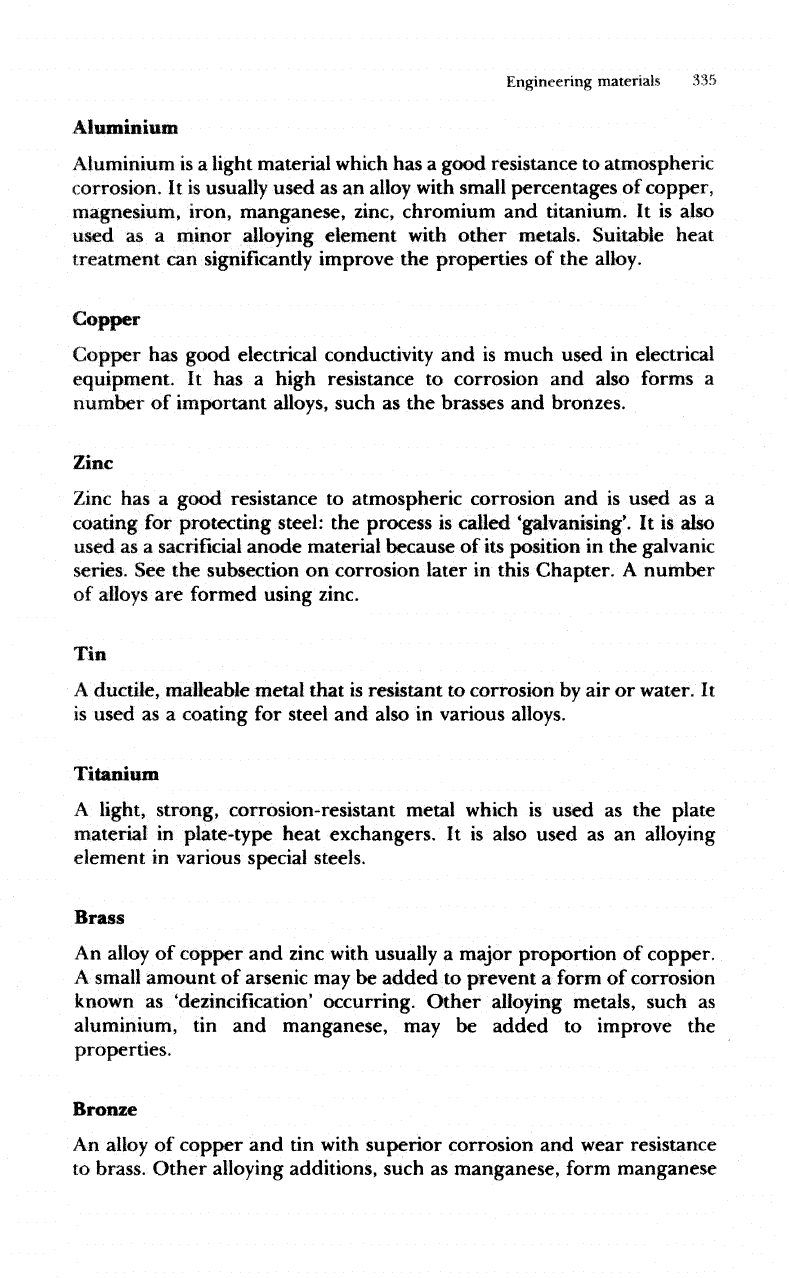
Engineering
materials
335
Aluminium
Aluminium
is a
light material
which
has a
good resistance
to
atmospheric
corrosion.
It
is
usually
used
as an
alloy
with
small
percentages
of
copper,
magnesium,
iron, manganese,
zinc,
chromium
and
titanium.
It is
also
used
as a
minor
alloying
element
with
other metals. Suitable heat
treatment
can
significantly
improve
the
properties
of the
alloy.
Copper
Copper
has
good electrical
conductivity
and is
much used
in
electrical
equipment.
It has a
high resistance
to
corrosion
and
also
forms
a
number
of
important
alloys,
such
as the
brasses
and
bronzes.
Zinc
Zinc
has a
good resistance
to
atmospheric corrosion
and is
used
as a
coating
for
protecting steel:
the
process
is
called
'galvanising'.
It is
also
used
as a
sacrificial
anode material because
of its
position
in the
galvanic
series.
See the
subsection
on
corrosion later
in
this Chapter.
A
number
of
alloys
are
formed using
zinc.
Tin
A
ductile,
malleable metal that
is
resistant
to
corrosion
by air or
water.
It
is
used
as a
coating
for
steel
and
also
in
various
alloys.
Titanium
A
light, strong, corrosion-resistant metal
which
is
used
as the
plate
material
in
plate-type heat exchangers.
It is
also used
as an
alloying
element
in
various special steels.
Brass
An
alloy
of
copper
and
zinc
with
usually
a
major
proportion
of
copper,
A
small
amount
of
arsenic
may be
added
to
prevent
a
form
of
corrosion
known
as
'dezincification'
occurring. Other alloying metals, such
as
aluminium,
tin and
manganese,
may be
added
to
improve
the
properties.
Bronze
An
alloy
of
copper
and tin
with
superior corrosion
and
wear resistance
to
brass. Other
alloying
additions, such
as
manganese,
form
manganese

336
Engineering
materials
bronze
or
propeller brass. Additions
of
aluminium
and
zinc
result
in
aluminium
bronze
and
gunmetal
respectively.
Cupro-nickel
An
alloy
of
copper
and
nickel
with
20 or 30% of
nickel.
Good strength
properties combined
with
a
resistance
to
corrosion
by sea or
ri¥er waters
make
this
a
popular
alloy.
Monel
metal
is a
particular
cupro-nickel
alloy
with
small
additions
of
iron, manganese, silicon
and
carbon.
White metal
Usually
a tin
based alloy with amounts
of
lead,
copper
and
antimony.
It
may
also
be a
lead based alloy
with
antimony. White metal
has a low
coefficient
of
friction
and is
used
as a
lining material
for
bearings.
Non-metallic
materials
Many
non-metallic materials
are in
general use.
Their
improved
properties
have resulted
in
their replacing conventional metals
for
many
applications.
The
majority
are
organic, being produced either
synthetic-
ally
or
from
naturally occurring material.
Ceramics
are
being increasingly considered
for
marine
use
particular-
ly
where galvanic corrosion
is a
problem.
Sintered
alpha silicon carbide
and
other silicon-based ceramics have good strength
properties
and are
inert
in sea
water.
The
general term
'plastic'
is
used
to
describe
many
of
these
non-metallic
materials. Plastics
are
organic materials
which
can be
moulded
to
shape under
the
action
of
heat
or
heat
and
pressure.
There
are two
main classes, thermoplastic
and
thermosetting, although some
more modern plastics
are
strictly neither. Thermoplastic materials
are
softened
by
heat
and can be
formed
to
shape
and
then
set by
cooling,
e.g. perspex, polyvinylchloride (PVC)
and
nylon. Thermosetting
materials
are
usually
moulded
in a
heated state,
undergo
a
chemical
change
on
further heating
and
then
set
hard,
for
example Bakelite,
epoxy resins
and
polyesters.
Some general
properties
of
plastic materials
are
good
corrosion
resistance,
good
electrical resistance
and
good thermal resistance;
but
they
are
unsuitable
for
high temperatures.
To
improve
or
alter
properties, various additives
or
fillers
are
used, such
as
glass
fibre
for
strength. Asbestos
fibre can
improve heat resistance
and
mica
is
sometimes
added
to
reduce electrical conductivity.
Foamed plastics
are
formed
by the
liberation
of gas
from
the
actual
material,
which
then expands
to
form
a
honeycomb-like structure. Such
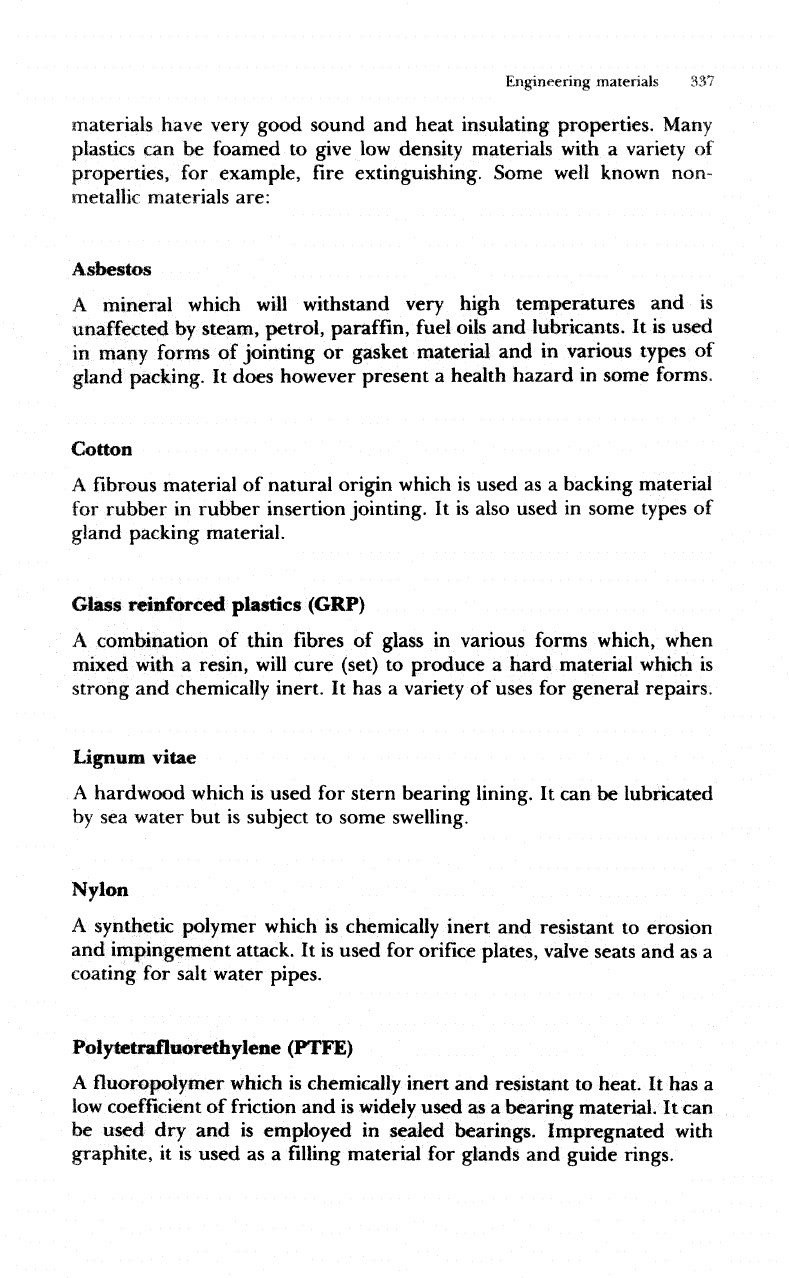
Engineering
materials
337
materials
have
very
good sound
and
heat insulating properties.
Many
plastics
can be
foamed
to
give
low
density materials
with
a
variety
of
properties,
for
example,
fire
extinguishing. Some
well
known
non-
metallic
materials are:
Asbestos
A
mineral
which
will
withstand very high temperatures
and is
unaffected
by
steam,
petrol,
paraffin,
fuel
oils
and
lubricants.
It is
used
in
many
forms
of
jointing
or
gasket material
and in
various types
of
gland
packing.
It
does however present
a
health hazard
in
some forms.
Cotton
A
fibrous
material
of
natural origin
which
is
used
as a
backing material
for
rubber
in
rubber insertion jointing.
It is
also used
in
some types
of
gland
packing
material.
Glass
reinforced
plastics
(GRP)
A
combination
of
thin
fibres of
glass
in
various forms
which,
when
mixed
with
a
resin,
will
cure (set)
to
produce
a
hard
material
which
is
strong
and
chemically
inert.
It has a
variety
of
uses
for
general repairs.
Lignum
vitae
A
hardwood
which
is
used
for
stern bearing
lining.
It can be
lubricated
by
sea
water
but is
subject
to
some
swelling.
Nylon
A
synthetic polymer
which
is
chemically inert
and
resistant
to
erosion
and
impingement attack.
It is
used
for
orifice plates,
valve
seats
and as a
coating
for
salt
water pipes.
Polytetrafluorethylene
(PTFE)
A
fluoropolymer
which
is
chemically inert
and
resistant
to
heat.
It has a
low
coefficient
of
friction
and is
widely used
as a
bearing
material.
It can
be
used
dry and is
employed
in
sealed
bearings. Impregnated
with
graphite,
it is
used
as a filling
material
for
glands
and
guide rings.
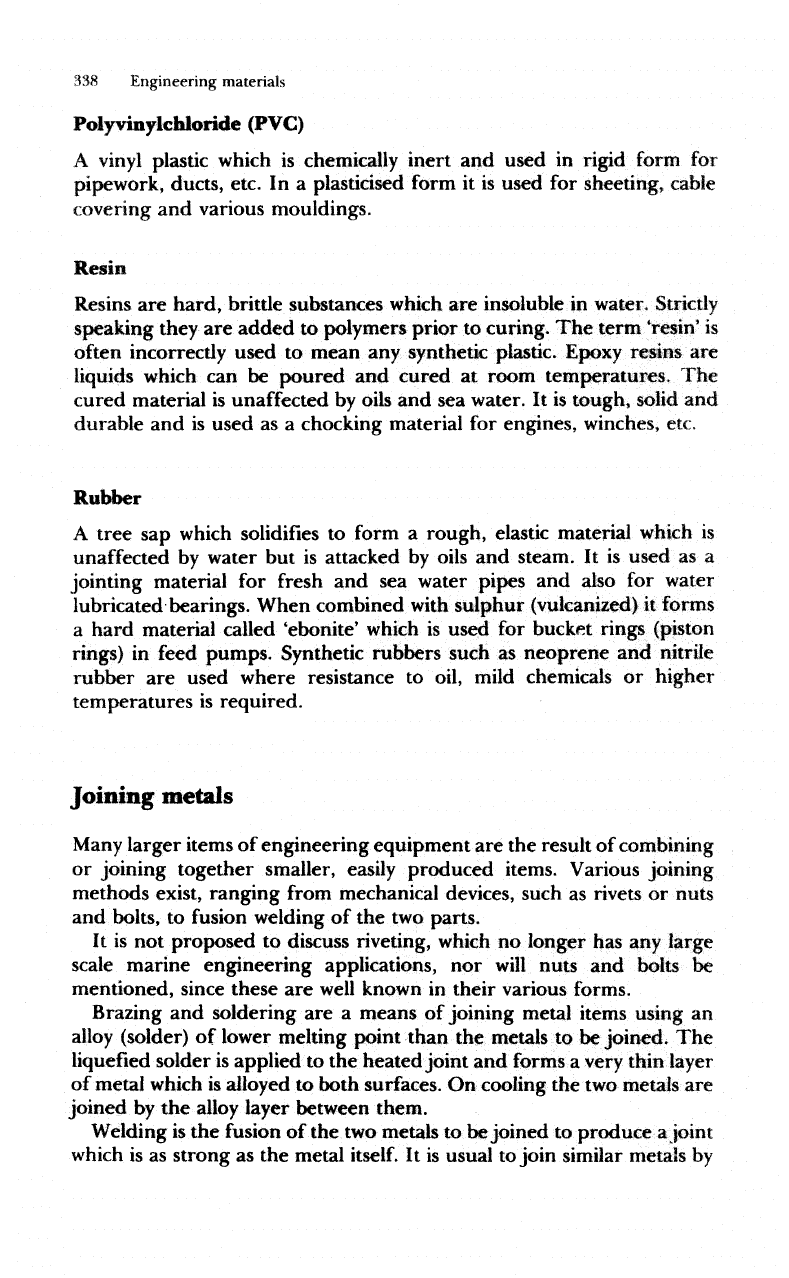
338
Engineering materials
Polyvinylchloride
(PVC)
A
vinyl
plastic
which
is
chemically inert
and
used
in
rigid
form
for
pipework,
ducts, etc.
In a
plasticised
form
it is
used
for
sheeting,
cable
covering
and
various mouldings.
Resin
Resins
are
hard,
brittle substances which
are
insoluble
in
water. Strictly
speaking they
are
added
to
polymers
prior
to
curing.
The
term
'resin'
is
often
incorrectly used
to
mean
any
synthetic plastic.
Epoxy
resins
are
liquids
which
can be
poured
and
cured
at
room temperatures.
The
cured material
is
unaffected
by
oils
and sea
water.
It is
tough,
solid
and
durable
and is
used
as a
chocking material
for
engines,
winches,
etc.
Rubber
A
tree
sap
which
solidifies
to
form
a
rough, elastic material
which
is
unaffected
by
water
but is
attacked
by
oils
and
steam.
It is
used
as a
jointing material
for
fresh
and sea
water pipes
and
also
for
water
lubricated bearings. When combined
with
sulphur
(vulcanized)
it
forms
a
hard material called
'ebonite'
which
is
used
for
bucket
rings
(piston
rings)
in
feed pumps. Synthetic rubbers such
as
neoprene
and
nitrile
rubber
are
used where resistance
to
oil,
mild
chemicals
or
higher
temperatures
is
required.
Joining
metals
Many
larger items
of
engineering equipment
are the
result
of
combining
or
joining together smaller, easily produced items. Various joining
methods exist, ranging
from
mechanical devices, such
as
rivets
or
nuts
and
bolts,
to
fusion
welding
of the two
parts.
It
is not
proposed
to
discuss
riveting,
which
no
longer
has any
large
scale
marine engineering applications,
nor
will
nuts
and
bolts
be
mentioned,
since these
are
well
known
in
their various
forms.
Brazing
and
soldering
are a
means
of
joining metal items using
an
alloy
(solder)
of
lower melting point than
the
metals
to be
joined.
The
liquefied
solder
is
applied
to the
heated
joint
and
forms
a
very thin layer
of
metal which
is
alloyed
to
both surfaces.
On
cooling
the two
metals
are
joined
by the
alloy layer between them.
Welding
is the
fusion
of the two
metals
to
be
joined
to
produce
a
joint
which
is as
strong
as the
metal itself.
It is
usual
to
join similar
metals
by

Engineering
materials
339
welding.
To
achieve
the
high temperature
at
which
fusion
can
take
place,
the
metal
may be
heated
by a gas
torch
or an
electric arc.
With
gas
welding,
a
torch burning oxygen
and
acetylene
gas is
used
and
rods
of the
parent plate material
are
melted
to
provide
the
metal
for
the
joint.
An
electric
arc is
produced
between
two
metals
in an
electric circuit
when
they
are
separated
by a
short distance.
The
metal
to be
welded
forms
one
electrode
in the
circuit
and the
welding
rod
the
other.
The
electric
"arc
produced,
creates
a
region
of
high
temperature
which melts
and
enables
fusion
of the
metals
to
take place.
A
transformer
is
used
to
provide
a
low
voltage
and the
current
can be
regulated
depending
upon
the
metal thickness.
The
electrode provides
the filler
material
for the
joint
and is flux
coated
to
exclude atmospheric gases
from
the
fusion
process.
Corrosion
Corrosion
is the
wasting
of
metals
by
chemical
or
electrochemical
reactions
with
their
surroundings.
A
knowledge
of the
various
processes
or
situations
in
which corrosion occurs
will
enable
at
least
a
slowing down
of
the
material wastage.
Iron
and
steel
corrode
in an
attempt
to
return
to
their stable oxide
form.
This
oxidising,
or
'rusting'
as it is
called,
will
take
place
wherever
steel
is
exposed
to
oxygen
and
moisture. Unfortunately
the
metal oxide
formed
permits
the
reaction
to
continue
beneath
it.
Some metals
however
produce
a
passive
oxide
film,
that
is, no
further
corrosion
takes
place beneath
it.
Aluminium
and
chromium
are
examples
of
metals
which
form passive oxide coatings.
Corrosion
control
of
this process
usually
involves
a
coating.
This
may be
another metal, such
as tin or
zinc,
or the use of
paints
or
plastic coatings.
Electrochemical
corrosion
usually
involves
two
different metals
with
an
electrolyte between them.
(An
electrolyte
is a
liquid
which
enables
current
to
flow
through it.)
A
corrosion cell
or
galvanic cell
is
said
to
have
been
set up.
Current
flow
occurs
in the
cell between
the two
metals
since they
are at
different
potentials.
As a
result
of the
current
flow
through
the
electrolyte,
metal
is
removed from
the
anode
or
positive
electrode
and the
cathode
or
negative
electrode
is
protected
from
corrosion.
A
corrosion cell
can
occur between different parts
of the
same
metal,
perhaps
due to
slight variations
in
composition, oxygen
concentration,
and so on. The
result
is
usually small holes
or
pits
and the
effect
is
known
as
'pitting
corrosion'.
A
more serious
form
of
this
effect
results
in
greater damage
and is
known
as
"crevice
corrosion'.
The
prevention
of
electrochemical corrosion
is
achieved
by
cathodic
